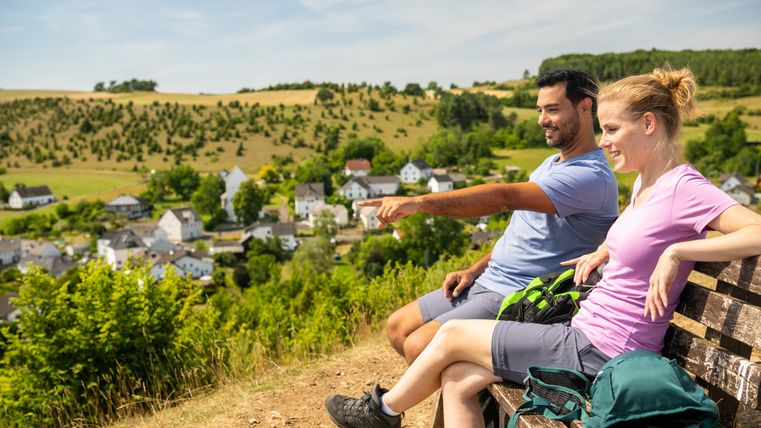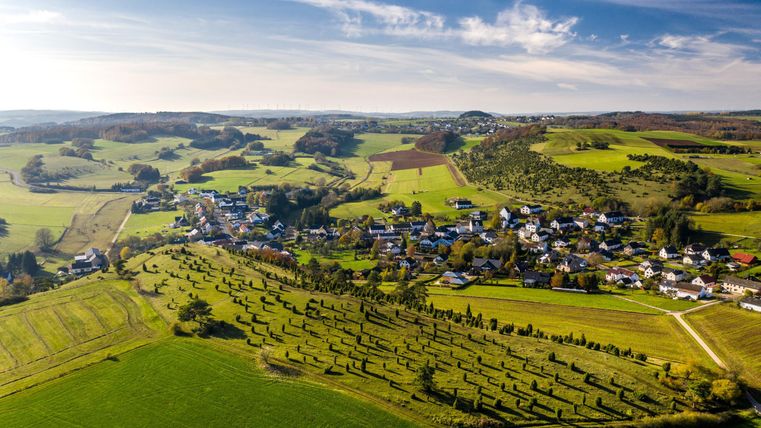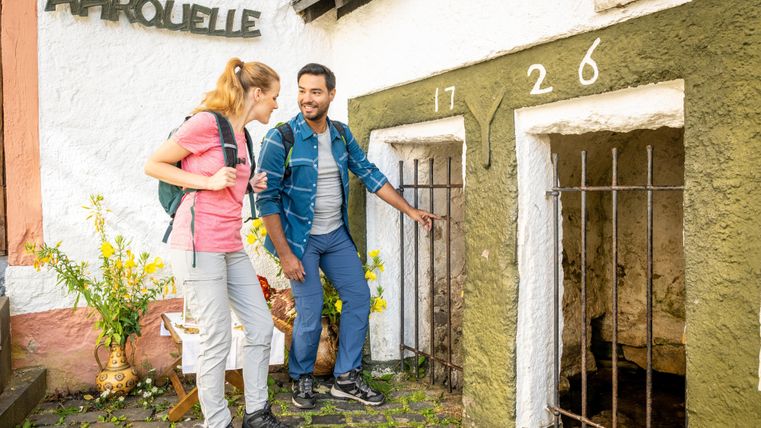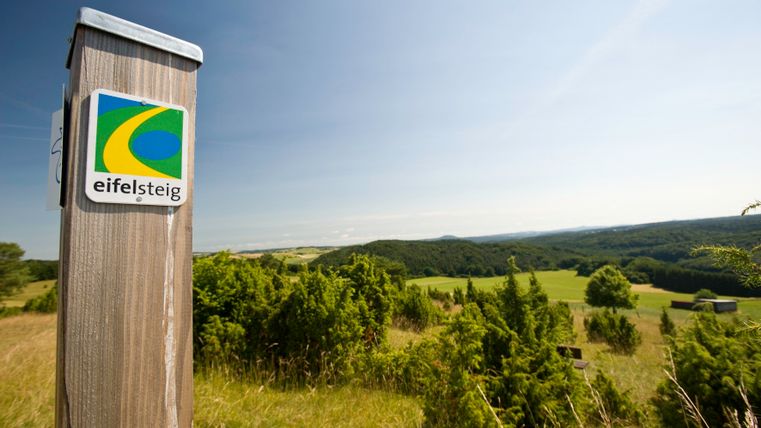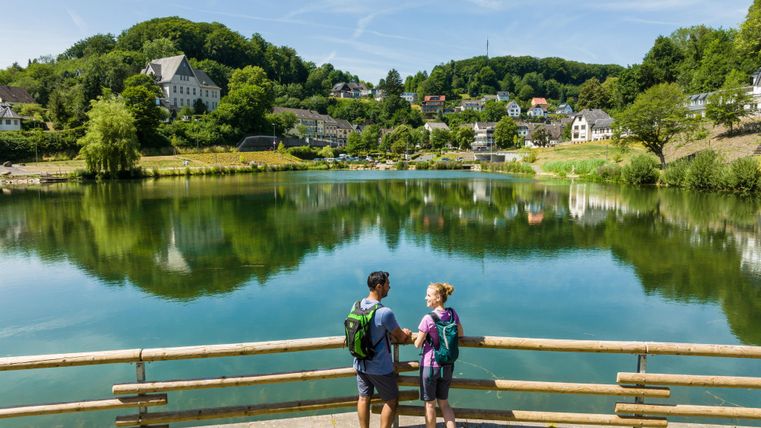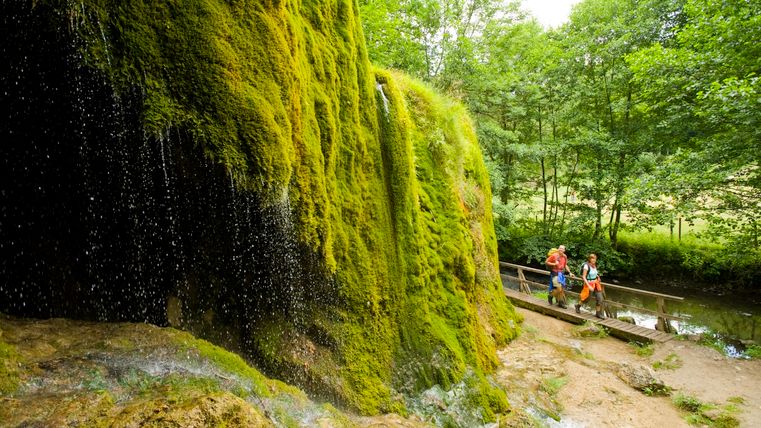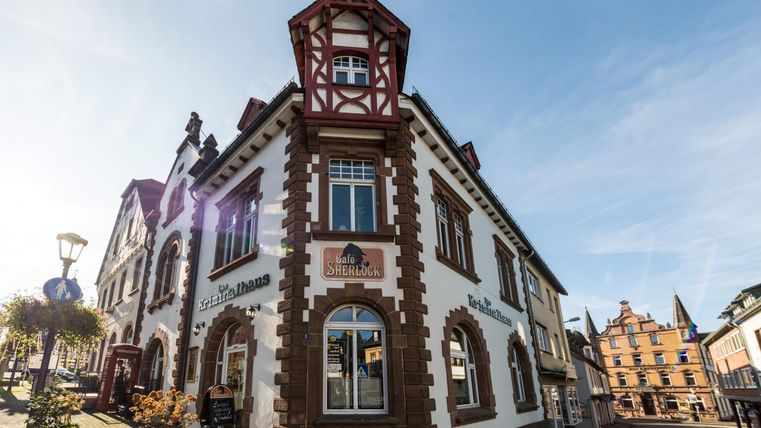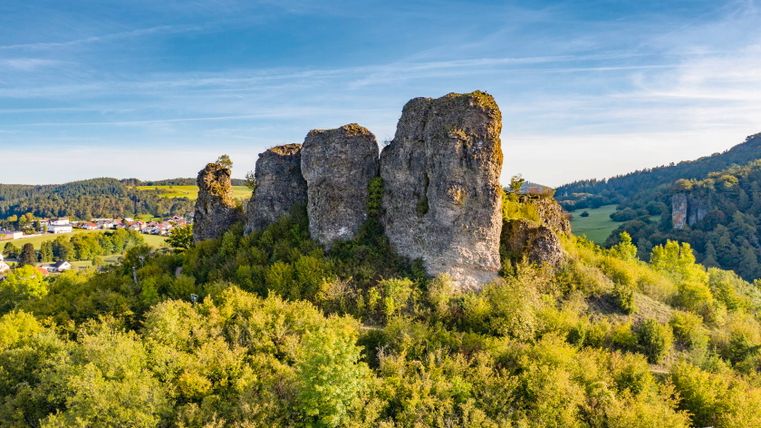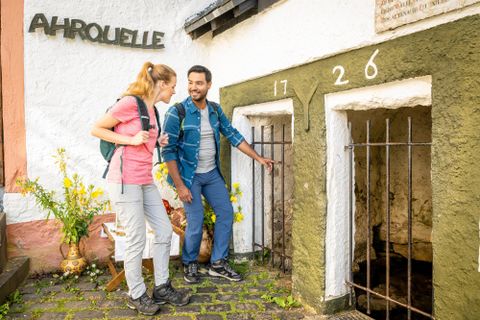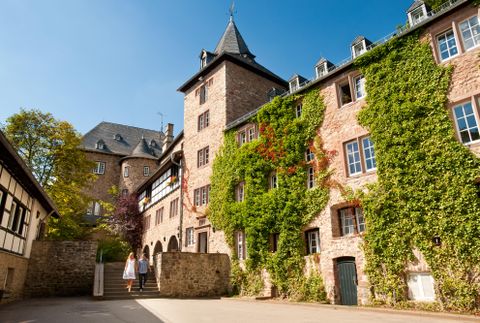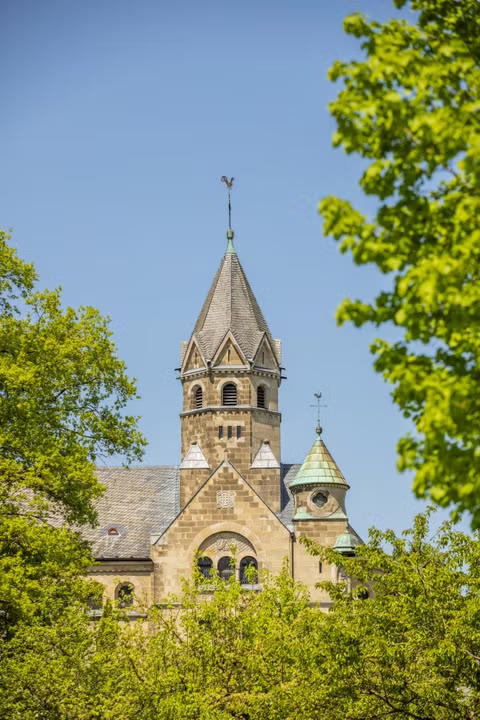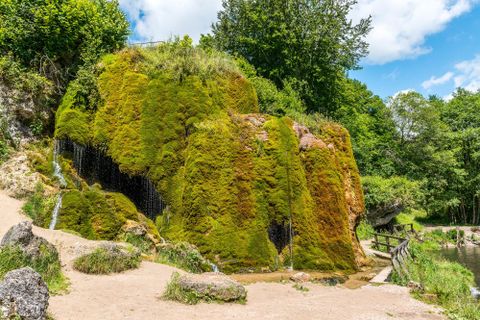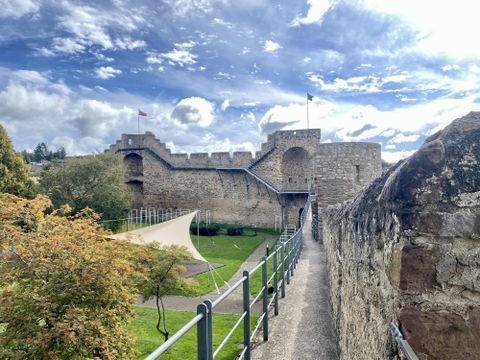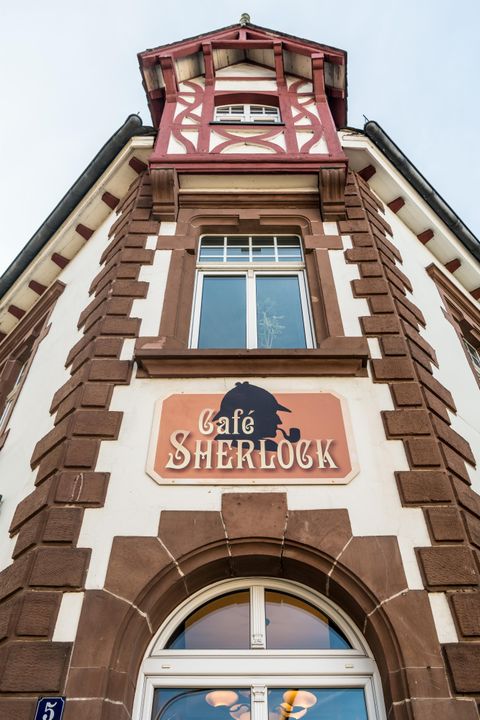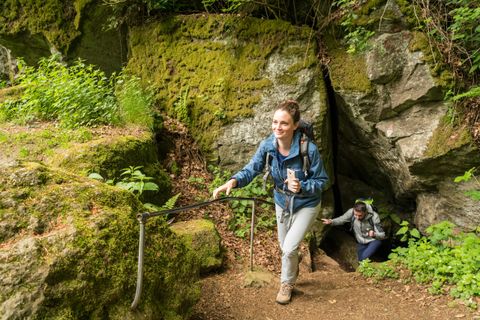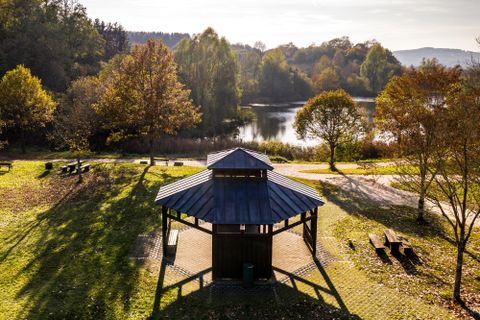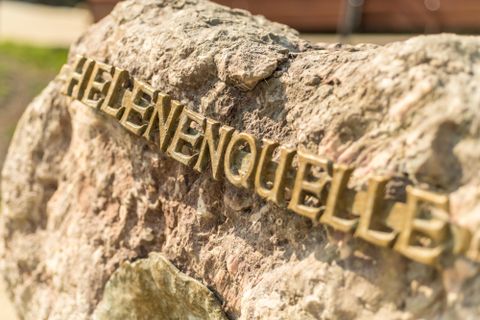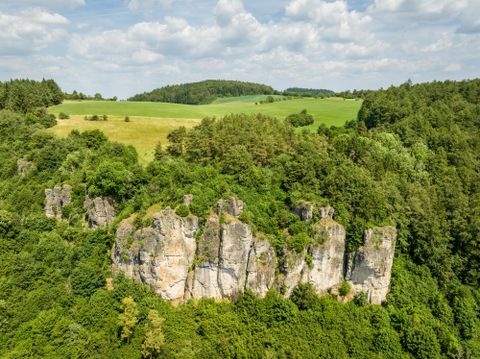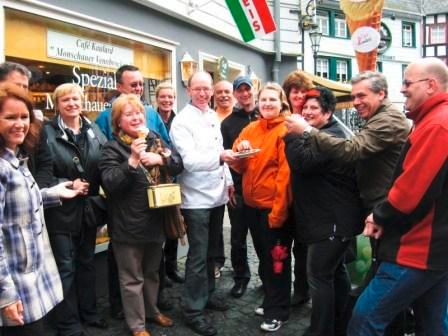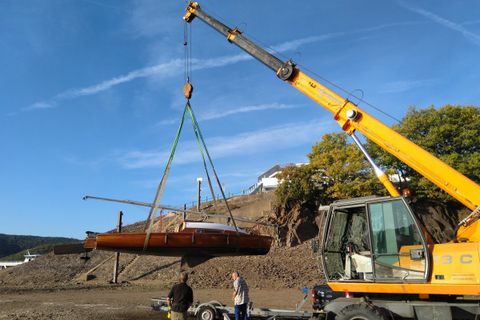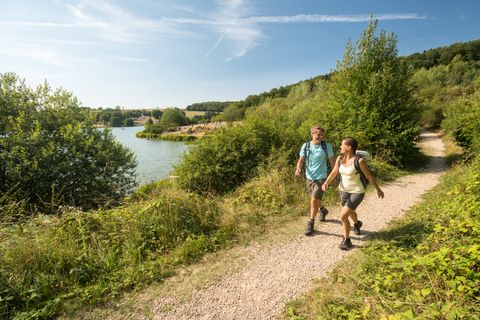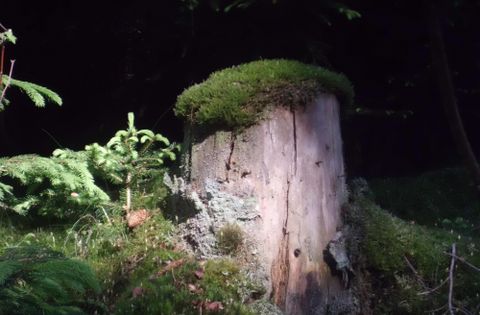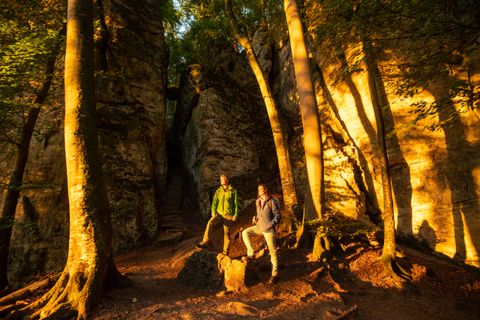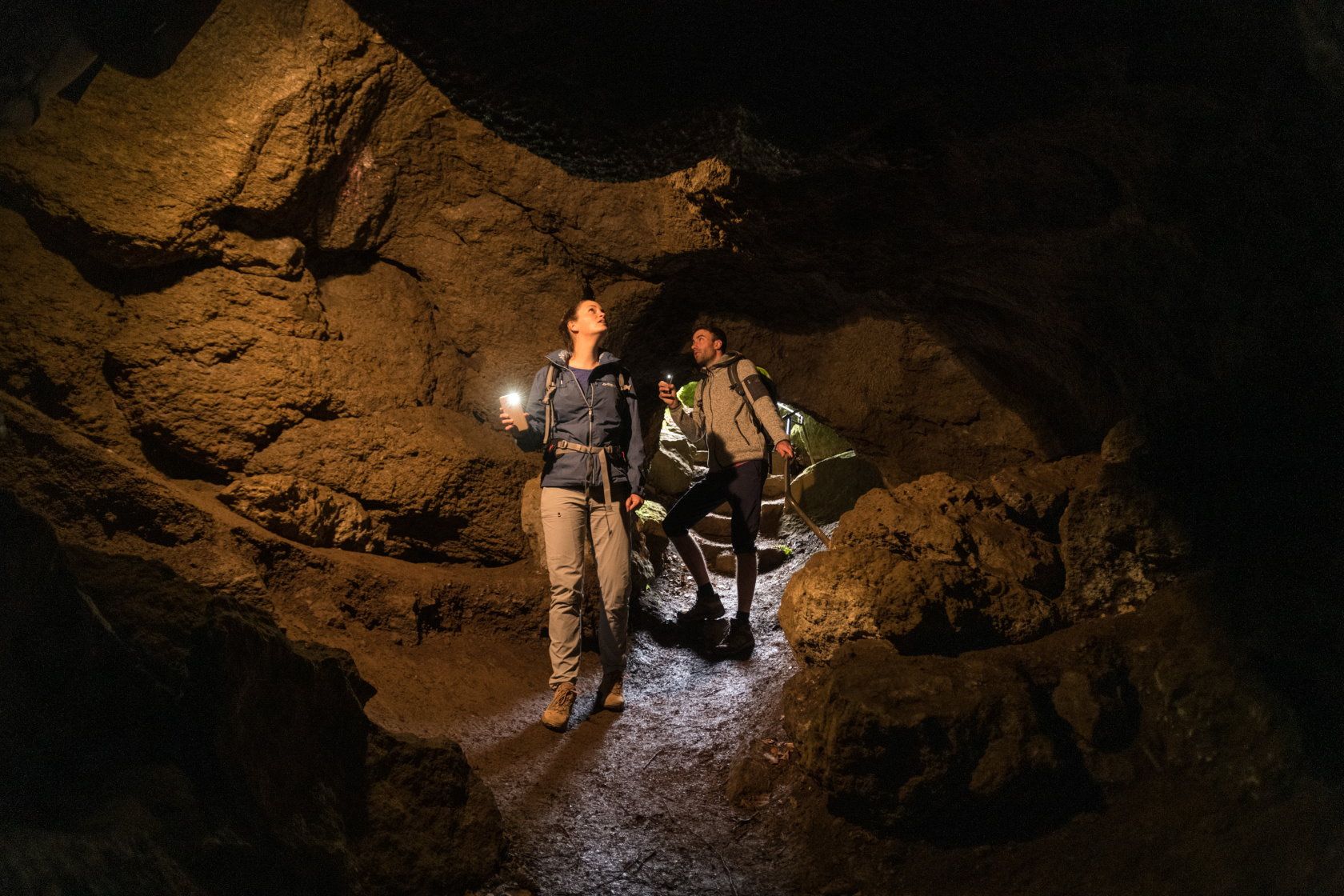
Wanderreise 22: Eifelsteig in kurzen Etappen Blankenheim - Gerolstein
✔Distance hike ✔Short stages ✔7 days ✔approx. 60.8 km ✔Blankenheim - Gerolstein
Hiking on the Eifelsteig in shortened stages from Blankenheim to Gerolstein
On the approximately 60 kilometers from Blankenheim to the fountain town of Gerolstein, you can enjoy a week of relaxed hikes that, at 9 to 14 kilometers per day, won't overtax anyone. Your feet will almost always touch ground that was once a warm tropical sea with numerous reefs in the Devonian period. Stromatopores, an already extinct, sponge-like group of animals and corals were their builders. Today, fossil-rich limestones bear witness to this prehistoric era. The Celts and Romans settled here thousands of years later, when the ground had long since been raised to become one of the most picturesque parts of the Eifel.
You start in the half-timbered and castle town of Blankenheim and see a unique feature of the Eifel: the Ahr rises in the middle of the town below a house. Nature and culture are one.
From the banks of the Ahr, you head up to the unique juniper landscape, which stretches from Alendorf to Wiesbaum like a "Tuscany of the Eifel" with its fragrant flora. Sweeping views and a chapel lined with pure gold await you along the way. Hillesheim , the capital of German-language regional crime novels and surrounded by a walkable town wall, will tempt you to take a break at Café Sherlock. And at the end, you will arrive in Gerolstein . The town is not only famous for its mineral water, but also for its spectacular rocky backdrop of vertically rising dolomite rock. The Kasselburg castle with its eagle and wolf park and the remains of a Celtic-Roman sanctuary are also enthroned here. It is dedicated to Caiva, a matriarchal deity.
You will enjoy the hospitality of comfortable accommodation at all stages. Packed lunches, luggage transfer and more sweeten your hiking vacation.
Impressions
Copyright: Eifel Tourismus GmbH, Dominik Ketz Copyright: Eifel Tourismus GmbH, D. Ketz Copyright: Eifel Tourismus GmbH, Dominik Ketz - finanziert durch REACT-EU Copyright: Rheinland-Pfalz Tourismus/D. Ketz Copyright: Eifel Tourismus GmbH, Dominik Ketz - finanziert durch REACT-EU Copyright: Rheinland-Pfalz Tourismus GmbH - Dominik Ketz Copyright: Eifel Tourismus GmbH, D. Ketz Copyright: Eifel Tourismus GmbH
Travel itinerary
Complete route: Blankenheim - Gerolstein
- approx. 60.7 km in total
Day 1: Arrival in Blankenheim
- Overnight stay in Blankenheim
Copyright: Eifel Tourismus GmbH, Dominik Ketz Ahrquelle
BlankenheimOpen todayIn the cellar of one half-timbered-house from 1726 you can find the spring of the river Ahr.
Day 2: Blankenheim - Alendorf (approx. 12.2 km)
- Hike on the Eifelsteig stage 7 from Blankenheim to Alendorf / approx. 12.2 km
- Transfer to the hotel
Copyright: Eifel Tourismus GmbH, Dominik Ketz Burg Blankenheim
BlankenheimOpen todayThe imposing castle dominates the image of Blankenheim. Finds indicate that a Roman fort previously stood here.
Day 3: Mirbach - Üxheim-Ahütte (approx. 14 km)
- Transfer to the start of the hike
- Hike on Eifelsteig stage 7 from Mirbach to Ahütte | approx. 14 km
- Overnight stay in Üxheim-Ahütte
Copyright: Eifel Tourismus GmbH, Dominik Ketz Erlöserkapelle Mirbach
WiesbaumOpen todayRemarkable is the oakportal, the mosaic work inside the church and the artistic stonework.
Day 4: Üxheim-Ahütte - Hillesheim (approx. 14 km)
- Hike on the Eifelsteig stage 8 from Ahütte-Hillesheim | approx. 9 km
- Overnight stay in Hillesheim
Copyright: Foto Achim Meurer, https://achimmeurer.com/ Growing waterfall Dreimühlen
ÜxheimOpen todayThe Dreimühlen waterfall is probably the most interesting waterfall in the Eifel. It was formed from limestone deposits of three spring tributaries of the Ahbach. Due to the constant deposition, the sinter bank is constantly "growing", which is where the name "growing waterfall" comes from.
Copyright: Touristik GmbH Gerolsteiner Land Stadt Hillesheim mit Stadtmauer
HillesheimOpen todayThe European Example town of Hillesheim has a host of attractions to offer: The historical area of the town, the town fortifications from the 13th century, the market places, the leisure area "Bolsdorfer Tälchen", St. Martin's Church.
Copyright: Eifel Tourismus GmbH, Dominik Ketz Hillesheim - Café Sherlock
Hillesheimclosed todayCafé, small dishes and soups
Day 5: Hillesheim - Müllenborn (approx. 11.4 km)
- Hike on Eifelsteig stage 9 from Hillesheim to Müllenborn (approx. 11.4 km)
- Overnight stay in Müllenborn
Copyright: Eifel Tourismus GmbH, Dominik Ketz The millstone caves of the Rother Kopf
GerolsteinOpen todayThe millstone caves are located northwest of Gerolstein, between the districts Müllenborn and Roth. For those who want to get really deep insights into the interior of the volcano Eifel, a visit to the Mühlstein caves is a must.
Copyright: Eifel Tourismus GmbH, Dominik Ketz Bolsdorfer Tälchen
HillesheimOpen todayLeisure time - The recreation area ''Bolsdorfer Tälchen''
Day 6: Müllenborn - Gerolstein (approx. 9.2 km)
- Hike on the Eifelsteig stage 9 from Müllenborn to Gerolstein | approx. 9 km
- Overnight stay in Gerolstein
Copyright: Eifel Tourismus GmbH, Dominik Ketz Helenenquelle im Gerolsteiner Kurpark
GerolsteinOpen todayThe Helenenquelle on the Kyll Cycle Path near Gerolstein Town Hall is a popular resting place for cyclists and hikers. The fresh mineral water comes from a depth of approx. 90 m and can be drunk free of charge from April-October from the brass tap. Here it is worth taking a break and the park is ideal for a small picnic in nature.
Day 7: Departure
- After breakfast, the hiking tour along the Eifelsteig ends
Copyright: Eifel Tourismus GmbH, Dominik Ketz Gerolsteiner Dolomiten
GerolsteinOpen todayThe rocks “Hustley”, “Munterley”, “Drohende Ley”, “Große Kanzel” and “Auberg” shape the cityscape from afar and form Gerolstein’s landmark. The most famous peak of the Gerolstein Dolomites is the "Munterley" - with an altitude of 482 meters.
Further information
- 6 x overnight stays/breakfast in hotels and guesthouses
- Guest transfer to the start of the stage
- Packed lunch per hiking day
- Luggage transfer from accommodation to accommodation
- Tour description: "Eifelsteig" hiking guide book
- On request: return transfer by cab
The combination of travel services offered to you is a package tour within the meaning of Directive (EU) 2015/2302.
You can therefore make use of all EU rights that apply to package tours. Information on your main rights under Directive (EU) 2015/2302.
- from € 569.00 per person in a double room
- Single room surcharge from € 150.00 (+surcharge for luggage transfer for only one participant)
- plus guest contribution / tourist tax (payment on site)
- optionally bookable: Cab return transfer
- 10/15/25 to 12/31/26
Eifel Tourismus GmbH
Kalvarienbergstraße 1
54595 Prüm
Request a quote
You can request the offer "Wanderreise 22: Eifelsteig in kurzen Etappen Blankenheim - Gerolstein" from the provider Eifel Tourismus GmbH here.
October 15, 2025 to December 31, 2026
